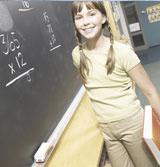The Sense of Sight
Printed from http://www.bodytalksystem.com//Learn/news/article.cfm?id=488 on Jul 03, 2025.
Dec 18, 2009
By Esther Veltheim
If you do have a meditation practice, then you already know the benefits of regularly quieting the mind and turning within. But for most of us westerners, classic meditation is something that does not seem to come easily. Whether you meditate already or not, the beauty of working with The Book of Fay is that it makes meditation something very natural to the mind.
The sense of sight is one of the most highly attuned senses. From the time we wake up in the morning, throughout our day, our eyes are our inbuilt video camera. When we look at things, the brain receives these images – which are actually received upside down – and processes and stores them much in the same way images are stored on a memory card in our video camera.
We do not actually see light; only the objects that it highlights. However, where the process of seeing isconcerned, light rays pass through the thick protective layer on the eye's surface that we call the cornea. These rays of light then enter into the lens of the eye via the pupil; the dark circle in the center of the eye.
The iris, the colored ring around the pupil, is a muscle. We can see how the iris muscle works when we are in a well lit room, or out in the bright sunlight and, quickly, the pupil constricts. When the pupil constricts or shrinks, the iris muscle is working to restrict the amount of light that enters the eye. Similarly, when we are in a room where the lights are low our pupil dilates; the pupil muscle functions to allow in as many light rays as possible.
Right behind the pupil is the lens of the eye which focuses the images we see through the jelly-like vitreous humor and onto the back of the surface of the eyeball; the retina. The retina is filled with millions of light-sensitive cells called rods and cones. The rods that are within the retina, function optimally in low light. The cones in the eye function best in bright light and their job is to identify color.
Both the rods and cones then send all of this complex information to the brain by way of the optic nerve. Because our inbuilt video camera receives all images upside down, the visual cortex part of the brain then has the immense job of turning the images the right way up. This is how the brain can then tell you what you are looking at.
 What happens next, of course, is that we have emotional,
intellectual and 'gut' responses to what we see. Depending on how the brain
computes and interprets what we see our body posture can change in response and
our entire bodymind complex is involved. Our actions and reactions to what we
see are all dependent on this beautiful and complex process.
What happens next, of course, is that we have emotional,
intellectual and 'gut' responses to what we see. Depending on how the brain
computes and interprets what we see our body posture can change in response and
our entire bodymind complex is involved. Our actions and reactions to what we
see are all dependent on this beautiful and complex process.
It is said that ten people can look at the same image and each will see it and experience it somewhat differently. This is because our mental and our physical conditioning all serve to distort or alter the object that is being viewed.
Although many of you probably knew much of this information already, I detail it here just to remind us why the sense of sight is considered one of the most complex and powerful senses.
In Monique's class the sense of sight is exposed to beautiful and magical images. These images portray nature in a way we never usually see it. But via Monique's lenses, both of her camera and her eye, she brings us a whole new experience of what nature has to offer us.
As already explained, it is impossible for the eye to receive images without the whole psyche (all the psychological processes) and body complex being involved. This is why the images from The Book of Fay have such powerful impact on us. They are images that the brain is not programmed to receive, such as is the case when we look at a flower or a field of corn.
Because the brain is unaccustomed to such images it becomes absorbed and the sense of sight might be said to work overtime. In this way the eye begins to focus on certain elements of the image we are looking at and, just like a portal, the image draws us in. What we are drawn into and what we experience will be unique to each of us.
The experience of working with Monique's images is of entering into realms of the psyche that we were previously unable to access. In this way, via the magic of nature, we begin to discover the inextricable connection between the inner and outer world.
We all struggle to feel whole and to bridge the gap between our outer world and our experience of it. Most of us live standing between the inner and outer, defending against both. When we step onto what we call our spiritual path all our efforts are concerted upon finding a way of reconciling these two (inextricable) worlds.
Perhaps this gives you a little idea as to the power of the work you will experience in Monique's class.
Esther








